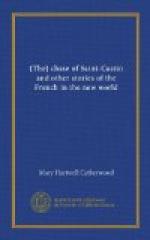Archange wheeled to look at her face. The widow was unmoved. She was little older than Archange, but her features showed a stoical harshness in the firelight. Michel, who often went to the lodges, widened his mouth and forgot to fill it with plum-leather. There was no sweet which Michel loved as he did this confection of wild plums and maple sugar boiled down and spread on sheets of birch bark. Madame Cadotte made the best pagessanung at the Sault.
“Look at the boy,” laughed Archange. “He will not want to go to the lodges any more after dark.”
The widow remarked, noting Michel’s fat legs and arms,—
“Windigo like to eat him.”
“I would kill a windigo,” declared Michel, in full revolt.
“Not so easy to kill a windigo. Bad spirits help windigos. If man kill windigo and not tear him to pieces, he come to life again.”
Archange herself shuddered at such a tenacious creature. She was less superstitious than the Chippewa woman, but the Northwest had its human terrors as dark as the shadow of witchcraft.
Though a Chippewa was bound to dip his hand in the war kettle and taste the flesh of enemies after victory, there was nothing he considered more horrible than a confirmed cannibal. He believed that a person who had eaten human flesh to satisfy hunger was never afterwards contented with any other kind, and, being deranged and possessed by the spirit of a beast, he had to be killed for the safety of the community. The cannibal usually became what he was by stress of starvation: in the winter when hunting failed and he was far from help, or on a journey when provisions gave out, and his only choice was to eat a companion or die. But this did not excuse him. As soon as he was detected the name of “windigo” was given him, and if he did not betake himself again to solitude he was shot or knocked on the head at the first convenient opportunity. Archange remembered one such wretched creature who had haunted the settlement awhile, and then disappeared. His canoe was known, and when it hovered even distantly on the river every child ran to its mother. The priest was less successful with this kind of outcast than with any other barbarian on the frontier.
“Have you seen him, Waubudone?” inquired Archange. “I wonder if it is the same man who used to frighten us?”
“This windigo a woman. Porcupine in her. She lie down and roll up and hide her head when you drive her off.”
“Did you drive her off?”
“No. She only come past my lodge in the night.”
“Did you see her?”
“No, I smell her.”
Archange had heard of the atmosphere which windigos far gone in cannibalism carried around them. She desired to know nothing more about the poor creature, or the class to which the poor creature belonged, if such isolated beings may be classed. The Chippewa widow talked without being questioned, however, preparing to reduce Archange’s mass of hair to the compass of a nightcap.




